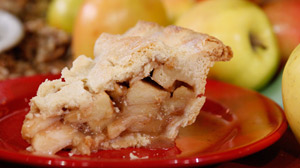An Apple a Day…
It’s that time of year again! The comfort food season is on its way and apples play a huge role in fall baking! This month, Brooke P. is here to explain the health benefits of apples as well as provide us with a few recipes she loves to use during this time of year. Yum!
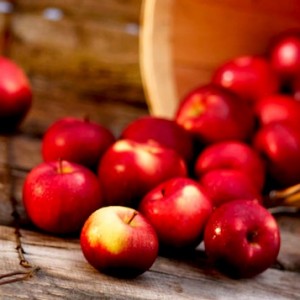
Even If you haven’t been to an orchard this year, you have undoubtedly seen piles of
local apples in dozens of varieties front and center in your favorite grocery store.
Admittedly, I didn’t like fresh apples as a child. Sure, I ate apple pie and my mom’s
homemade apple sauce, but I turned my nose up at fresh whole apples. Looking back, I
think it was largely because we only had mushy Red Delicious. Later, as an exchange
student living in Germany, I discovered additional varieties, and fell in love with a small,
tart-sweet variety that grew on my host family’s apples trees.
Today, the variety of apples in orchards and in supermarkets is seemingly endless. They
come in so many varieties, that there is one to fit nearly everyone’s taste. What’s more,
apples are cheap, portable and many varieties will keep for months when properly
stored. According to the Purdue University Cooperative Extension Service, the ideal
conditions for apple storage are a temperature of between 30°- 32°F, relative humidity of
90 percent and some air circulation. Practically, storage can be best achieved by
placing apples into a plastic bag with a few holes for air circulation, then stored in a cold
cellar or refrigerator crisper drawer (where the humidity settings can often be adjusted).
Since bruised or damaged apples emit ethylene (a gas that increases ripening) more
rapidly, it is best to use them immediately. At the very least, store the bruised fruit away
from other fruit (unless you are trying to ripen another fruit like bananas, pears or
peaches).

Nutritionally, apples pack a punch! They are loaded with nutrients, fiber and
phytochemicals (strong antioxidants) that keep you healthy by helping prevent chronic
diseases, including type 2 diabetes, some cancers, asthma and cardiovascular disease.
Studies on of several of the antioxidants found in apples, including quercetin, catechin,
phloridzin and chlorogenic acid, have been shown to inhibit growth of cancer cells,
decrease lipid oxidation and even lower cholesterol. Pectin, a type of soluble fiber found
in apples, helps reduce cholesterol by binding it in the gastrointestinal tract and can also
help stabilize blood sugar. The phytochemical content of apples varies among varieties,
and while it can be reduced through processing, remains stable during storage. In this
regard, eating the whole fruit provides the most benefit. Many of the nutrients are also
concentrated in the skin, so ditch the peeler and enjoy a variety of colorful apples.
When shopping for apples, most orchards and supermarkets will have a list of varieties
and what they are best used for. For example, Granny Smith and Fuji apples hold their
shape well and are great for pies and tarts, as well as baking and eating. Other varieties
like Cortlands or Golden Delicious tend to break down more easily when cooked and
good for making apple sauce or combined with a firmer variety in pies.
On the other hand, apples top the Environmental Working Group’s Dirty Dozen Plus list
of produce most likely to contain pesticide residues. To reduce your risk, ideally, choose
organic varieties grown without (or at least minimal) pesticides, especially if you eat
them regularly. However, conventional apples are also a healthy choice! Just be sure to
wash them well before eating. Either way, be assured that the benefits of including
apples in your diet, especially while they are in season, are definitely worth it.
One of my favorite apple combinations for making a deep dish apple pie are Cortland
and Jonathan. After several years of my pies coming out with the apples not quite soft
enough, I found this recipe for a Deep-Dish Apple Pie from Emeril Lagasse that calls for
pre-cooking the filling. I also found that using two varieties of apples (one that breaks
down and the other that holds it’s shape), creates the perfect texture. Over the years,
I’ve added my own twists and substitutions on this pie recipe, including my mom’s
influence of using some lard instead of shortening in the pie crust for flakiness. I usually
make two batches and freeze one for a jump start on Thanksgiving.
Ingredients
3 tablespoons butter
2 pounds Granny Smith apples, sliced 1/2-inch thick
2 pounds Macintosh Apples, sliced 1/2-inch thick
1/2 cup sugar
1/2 cup light brown sugar, packed
1 lemon, juiced
4 tablespoons all-purpose flour
Pinch ground nutmeg
1 teaspoon ground cinnamon
1/2 teaspoon salt
1 cup pecan pieces (these can easily be omitted, especially when food allergies are a
concern)
1 recipe Pie Dough, recipe follows
1 egg, beaten
4 ounces Wisconsin Sharp Cheddar, grated (sometimes, I simply sprinkle the crust with
raw sugar)
8 scoops vanilla ice cream
Directions
Preheat the oven to 350 degrees F.
In a large saute pan, melt the butter. Add the apples and saute for 2 minutes. Add the
sugars, lemon juice and flour. Continue to saute for 2 minutes. Season the apples with
nutmeg, cinnamon, and salt. Mix thoroughly and remove from the heat. Mix in the
pecans. Cool the mixture.
Lightly dust a surface with flour. Cut the dough in half. Roll out each half to 12 inches in
diameter and about 1/8-inch thick. Fold 1 circle of dough in fourths. Carefully lift the
dough and place in a 10-inch deep-dish pie pan. Unfold the pie dough and spoon the
apples into the pie shell. Place the second round of dough over the apples. Using a
sharp knife cut away the excess dough. Using your fingers, crimp the edges of the pie
firmly to seal the dough completely. With the same sharp knife, make 3 slits, about 4
inches long and 2 inches apart, across the pie dough. Brush with the beaten egg, place
the pie in the oven, and bake for 1 hour and 15 minutes.
Remove the pie from the oven and sprinkle the cheese over the top. Return the pie to
the oven and continue to cook for 8 minutes or until the cheese is bubbly. Let cool to
room temperature before slicing, about 1 hour. Serve with vanilla ice cream.
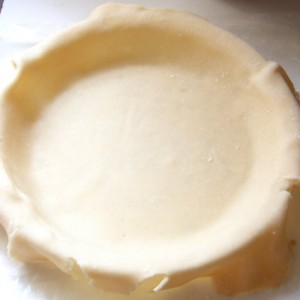
Pie Dough
2 1/2 cups all-purpose flour
1 1/2 tablespoons sugar
3/4 teaspoon salt
11 tablespoons cold unsalted butter, cut into 1/4-inch pieces
3 tablespoons solid vegetable shortening
5 tablespoons ice water
Sift the flour, sugar, and salt into a large bowl. Using your fingers, work in the butter and
shortening until the mixture resembles coarse crumbs. Add 4 tablespoons of ice water
and work with your fingers until the water is incorporated and the dough comes
together. Add more water as needed just until the dough comes together, being careful
not to over mix. Form the dough into a disk, wrap tightly in plastic wrap, and refrigerate
for at least 30 minutes before using.
Yield: enough for 1 double crust pie
My favorite pie crust recipe is similar. It also calls for being careful not to over mix the
dough, though in my opinion, using a food processor to pulse the ingredients together
makes things a little easier! This also give you a little extra dough to make fun cut-outs
for decorating the pie (or just rolling out, sprinkling with cinnamon and sugar, baking and
eating!)
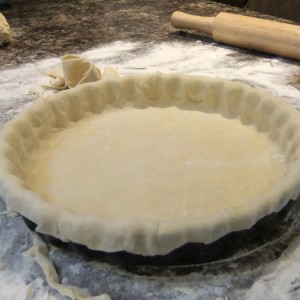
Brooke’s Pie Dough (adapted from a recipe I obtained from the former ‘A Cook’s
Table’ store in Baltimore, MD)
3 cups all-purpose flour
1 1/4 teaspoons salt
1/4 cup + 2 Tablespoons ice water
1/2 cup + 1 Tablespoon unsalted butter
1/2 cup + 1 Tablespoon lard or trans-fat free shortening
1 egg white + 1 teaspoon water (for brushing dough before baking)
1. Mix flour and salt in a large bowl.
2. Cut lard & butter (or trans-fat free shortening) until the size of peas with fingers, fork
or a pastry blender.
3. Add 1/4 cup water, 1 tablespoon at a time, stirring lightly with a fork. Add more water,
1 teaspoon at a time, if pastry is too dry to hold together.
4. If using a food processor, pulse shortening in; then add ice water in a trickle through
the feed tube (4-5 seconds total).
5. Gather the dough lightly into a ball using a rolling pin, roll out the dough, dusting with
flour as you go. Use a light stroke and roll rather than push the dough. Dough should
be soft, but not sticky. Keep picking it up and turning it over again and again as you
work, dusting with more flour if it gets sticky. Roll until it is large enough to drape into
the pie dish with about 2 inches of overlap.
6. For a two-crust pie, lay the bottom circle very loosely in the dish. Do not pull the
dough! To prevent sogginess, brush the shell with a beaten egg white.
7. If it’s a one-crust pie, you may want to pre-bake the shell for 15 minutes at 400
degrees. First, prick the crust in the shell with a fork; use rice or pie weights on top of
foil to hold the dough in shape. Bake 8 minutes, remove foil and bake 5 more
minutes. Cool, then fill.
8. Roll out excess dough and use pie or small cookie cutters to make shapes to place
on top of the pie. You can also roll out the dough, sprinkle with cinnamon and sugar
and bake it on a cookie sheet until starting to brown (watch closely!).
Note: For those of you looking for a gluten-free pie crust, I recently tried the Grandma’s
Pie Crust recipe from Cup4Cup (using half butter, half lard) and found it very good and
fairly easy to work with.
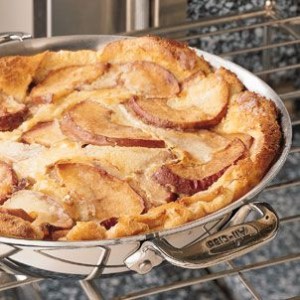
My other favorite apple recipe is a Dutch Apple Pancake from the Williams-Sonoma
Breakfasts and Brunches cookbook.
Dutch Apple Pancake
For the Apple Filling:
2 tablespoons unsalted butter
3 large Granny Smith or other firm, tart apples, peeled, halved, cored and thinly sliced
6 tablespoons (3 oz/90g) granulated sugar
1 teaspoon ground cinnamon
For the Pancake:
3 eggs
1/2 cup (2.5 oz/75g) all-purpose flour
1/2 cup (4 fl oz/125g) milk
1 tablespoon sour cream
1/4 teaspoon salt
1 teaspoon grated lemon zest
Confectioner’s (icing) sugar
Preheat oven to 400 degrees. To make filling, in a 10-inch (25-cm) ovenproof frying pan
over medium-high heat, melt the butter. Add the apples, sugar and cinnamon and saute,
stirring constantly, until the apples begin to soften and brown lightly, 3-5 minutes.
Remove from heat.
To make the pancake, in a bowl, using an electric mixer set on medium speed, beat the
eggs until frothy. Add the flour, milk, sour cream, salt and lemon zest and beat just until
a smooth batter forms.
Immediately pour the batter over the apples in the hot pan and place in the oven. Bake
until nicely puffed and golden brown, about 25 minutes.
Using a small fine-meshed sieve, lightly dust confectioners’ sugar over the top. Serve
directly from the pan, cut in half or into wedges.
Serves 2-4.
Note: I have substituted a cup-for-cup gluten free flour for regular flour, and it worked
well.
We’ve all heard the old adage, “An apple a day, keeps the doctor away.” While eating
apples regularly probably won’t keep you from catching that winter cold or flu, a healthy
diet that includes apples can certainly help your body’s own defenses do their job better!
In summary, any way you eat them, apples are an inexpensive, easy way to pack a
tasty nutrition punch. Now I’m off to eat my favorite, a Honeycrisp!
References:
Boyer J and Lui RH. Apple phytochemicals and their health benefits: Nutr J. 2004 May
12;3(1):5. 2004. PMID: 15140261
Purdue University Cooperative Extension Service
Jenkins DJ, Leeds AR, Gassull MA, Cochet B, Alberti GM. Decrease in postprandial
insulin and glucose concentrations by guar and pectin.Ann Intern Med. 1977 Jan; 86(1):
20-3.
Lattimer J and Haub M. Effects of dietary fiber and its components on metabolic health.
Nutrients. 2010 Dec;2(12):1266-89. doi: 10.3390/nu2121266. Epub 2010 Dec 15. PMID:
3257631
Kolpas, N., & Williams, C. (1997). Breakfasts & brunches. Alexandria, Va.: Time-Life
Books.
Thank you Brooke! These would be great to try this upcoming fall or Thanksgiving Break! Have a great weekend everyone!

